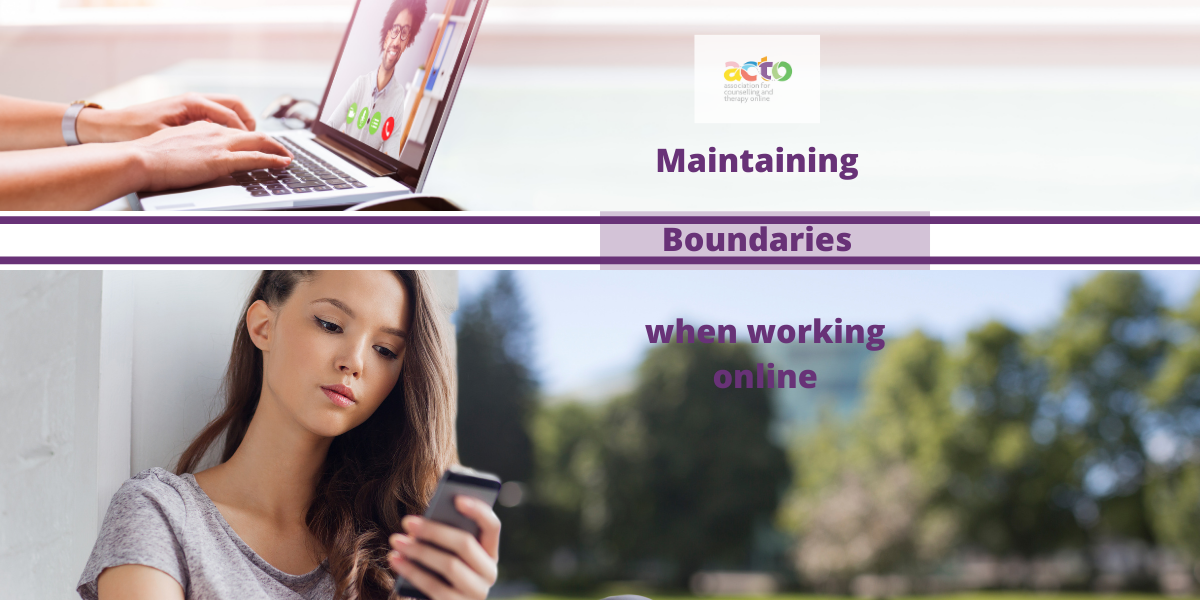As we have all been getting used to working online over the last few months, I have been conscious of a renewed focus that has been needed to create and maintain robust boundaries with our clients. Particularly given that for most of us this is new way of connecting with our clients.
We tend to take for granted the control we have over the counselling environment. Whether we work in an office away from our homes, or in a dedicated therapy space at home, we have full choice over what the space looks like, the ‘feel’ we wish to convey to help our clients feel safe, who and when someone enters this space, and when the session is ended.
Whereas, meeting our clients online means conducting sessions in their space, their homes, with no control over the room they choose to be in, and reduced influence over the potential for interruptions. We have limited control over technological glitches that may interrupt or prematurely end the session, while we do have control over the online communication platform that is used to hold the sessions on. Meaning we can maintain boundaries regarding the client’s data security and online confidentiality.
When technological issues arise, it is vital to have clearly set out in your contracting what you will do to try and reconnect, and if this is not possible, what alternative communication you will use to continue the session or rearrange. Knowing this process, along with your calm response in the moment, will help the client feel confident and safe with you. They will know that you are maintaining the boundaries through the clarity in how you will deal with the situation, and your firmness with time boundaries. It may be tempting to go over time to compensate for a technological problem that has arisen, while this pushes a boundary and sets a precedent that may be always be possible to repeat in the future.
The importance of remaining firm with your boundaries is further illustrated by the range of possible interruptions that can occur when the client is in their own home. From a child or partner entering and staying in the room, to a parent wanting to ‘meet’ the counsellor uninvited. Whatever the client says in terms of them being ok with the child or partner staying in the room, it is important to explain the reason for, and role of, confidentiality. I have spoken to counsellors who struggled to convey this firmly as the client was in ‘their’ home and so they felt that it is the client’s choice who is in the room. Explained clearly, the client will understand, and is often relieved at having a professional state on their behalf, what the boundaries are.
When you first entered your counselling room, I would guess that you spent time creating a therapy space that conveys a sense of safety, calm, professionalism, and security. A space where they can metaphorically leave their stories, traumas, and feelings in when they leave the session. Thus, creating a safety boundary to support the client to disclose and explore painful experiences and feelings. I often tell my clients that there is a bottomless pit in the space between us, for everything to go into. This is a double message; that they can leave behind what they have disclosed and shared in the room, and a self-care message to myself, that I do not expect to be left holding onto all my clients feelings and traumatic experiences.
This self-care message is even more vital now we are all working from home and may be doing so for some time. You may now be working from a room previously delegated as a social or family space. So, have been considering how to maintain physical boundaries, of no interruptions; and the emotional boundaries, by working out a process to step out of your counsellor persona into your private one as you walk out of the room.
This heightens the importance of discussing with your client what they will do immediately after the session to create a boundary between their counselling and the rest of their lives. Will they need time to process, and shift their emotions before able to re-join their family? Is this time available, or will they be expected to end the session and walk straight back into family life?
Working online reveals boundaries considerations for both the client and counsellor that do not arise when working within your own therapy space. By taking time to consider what they are and discussing them in your contracting will ensure that you both have clarity when responding boundary challenges. Which will help create a safe, secure space for your clients, and support your self-care when working from home.
Sarah Worley-James
This was first published in the BACP Cyberwork column

